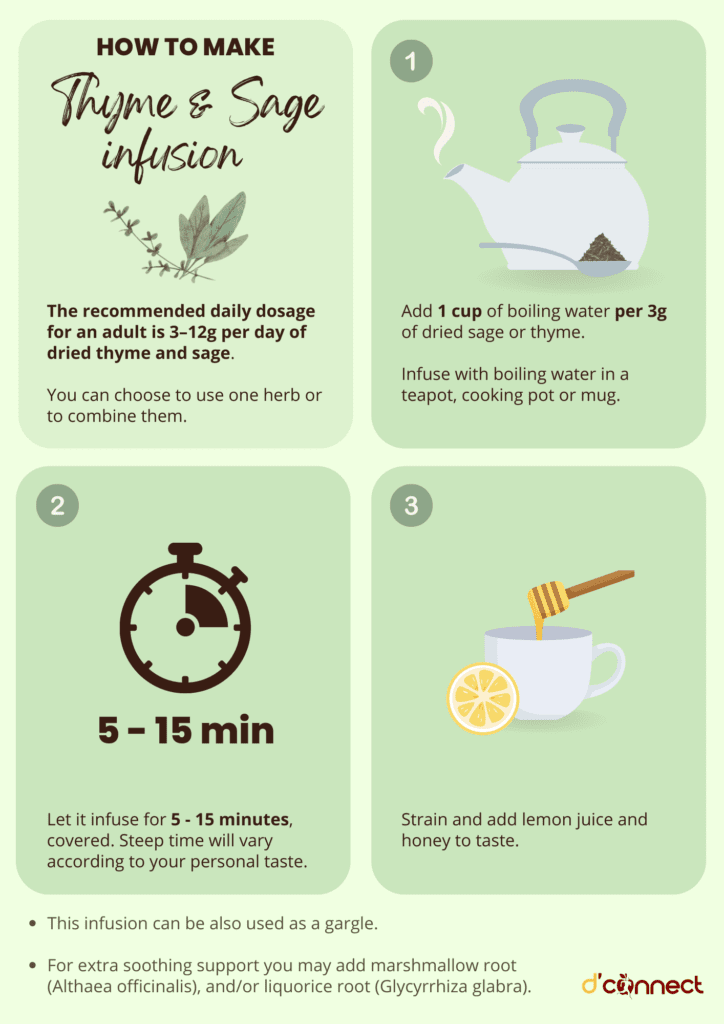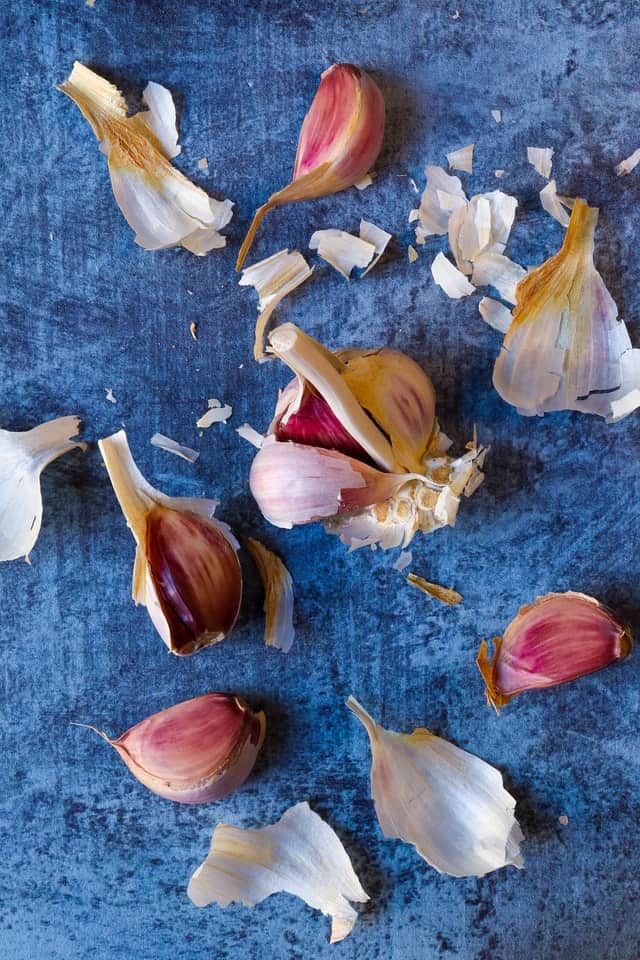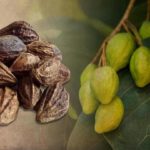
Paloma Velasquez
BNHM (New Zealand), MD (Chile)
Yes, winter is here. This means shorter days, less sun and more things circulating around that are ready to test our immune system.
That is why it’s good to be prepared and stock up with different herbs at home that can support our respiratory system for specific conditions. Some of these herbs are
- Eucalyptus
- Sage
- Thyme
- Marshmallow root
- Garlic
If you are under the weather at the moment, don’t worry – soon you will be able to take a deep breath again.
Sinuses and respiratory health
Sinuses are four sets of bony cavities in our head, connected by fine canals with the nasal cavity.[1]
Sinuses help to balance the air temperature and humidity of the air that we breathe, give tone to our voice and also, by being cavities, lighten the bone structure of the head.[2]

Sometimes sinuses can become obstructed and mucus can build up, and this can be caused by sinusitis.
Sinusitis is an inflammation of the mucous membrane that lines the sinuses. Causes for sinusitis include
- Infection
- Allergies
- Mold
- Polyps
- Deviated septum
- Weak immune system[1]
Smoking increases the risk of sinus infections
When sinusitis occurs it is important to know the cause in order to provide adequate treatment and relief from symptoms.
Signs and symptoms of sinusitis are
- Nasal congestion and mucus secretion
- Post nasal drip (feeling of mucus dripping down the throat)
- Facial pressure (nose, eyes and forehead)
- Headache
- Toothache
- Earache
- Bad breath (halitosis)
- Cough
- Feeling tired
- Fever[1]
How to relieve sinusitis
A great start to dealing with sinusitis at home is to have steam inhalations with fresh or dried eucalyptus leaf (Eucalyptus spp.) or essential oil.
A steam inhalation with eucalyptus may aid with blocked sinuses, mucus production and infection.
Eucalyptus (Eucalyptus spp.) has been used for respiratory conditions for a long time. The monoterpene 1,8-cineole or eucalyptol has shown mucolytic and spasmolytic activity on the respiratory tract, and is considered to have anti-inflammatory properties.

The content of 1,8-cineole varies between species, but also within the same species. Essential oils with a high content are Eucalyptus globulus and Eucalyptus radiata.[3,4,5,6]
To summarize, Eucalyptus is renowned for its decongestant properties and is considered to possess antibacterial, antifungal, and anti-viral properties.[7]
How to do eucalyptus steam inhalation
Step 1
Eucalyptus leaves should be crushed and placed into a pot or a bowl with boiling or very hot water. Alternatively you can use eucalyptus essential oil, ideally high in 1,8-cineole.
Step 2
Place a towel over your head, lean over the bowl and inhale the steam. This may help with congestion, and have a clearing effect of the airways, making it easier to breathe. Repeat throughout the day as necessary.

If symptoms do not improve or sinusitis occurs frequently, please contact your GP. Other common herb that can assist through steam inhalation is chamomile.[8]
RELATED — Chamomile (Matricaria chamomilla)
Important note – Eucalyptus products should not be used on the face or nose of babies and young children.[4]
Throat and respiratory health
Inflamed or sore throat can happen due to many reasons such as
- Viral infections (common cold, influenza, mononucleosis, measles, chickenpox, COVID-19)
- Bacterial infections (e.g. Streptococcus pyogenes)
- Allergies (pet dander, molds, dust, pollen)
- Dry indoor air
- Irritants (smoking, chemicals)
- Muscle strain
- Gastroesophageal reflux disease (GERD)
- Tumor[9]
Some of the great herbs to have at home for throat issues like laryngitis, pharyngitis and tonsillitis are sage (Salvia officinalis) and thyme (Thymus vulgaris) since both possess antiseptic properties.[10]
Inflamed throat and sage (Salvia officinalis)
Sage leaves have a drying, astringent effect on inflamed tonsils and throat. Sage leaf tea can be used as a gargle for tonsillitis and pharyngitis.[7]
Chemical constituents for sage leaf include
- Tannins (salviatannin)
- Essential oils (alpha and beta-thujone, camphor and 1,8-cineole)
- Flavones
- Phenolic acids
- Phenylpropanoid glycosides
- Triterpenoids
- Diterpenes[11]
Caution is recommended for long term uses of sage, with the exception for low thujone varieties.[10] The amount of thujone is lowest when the herb is flowering, and the amount of camphor diminishes as the herb grows.[12]

Thujone is considered to be a neurotoxin and it can produce headaches at high dosages, central nervous system stimulation and possibly epilepsy.[12,13]
Important note – Sage is not recommended during pregnancy and it is considered that it may reduce milk flow. Still, there is little research that evaluates the effect of sage on milk supply.[14]
Other herbs that might support a sore throat are Horehound (Marrubium vulgare) and Hyssop (Hyssopus officinalis).[8]
Inflamed throat and thyme (Thymus vulgaris)

Thyme is native to the Mediterranean region, and has been used for culinary purposes for a long time.
Adding to this, thyme has also been used as traditional herbal medicine for respiratory conditions such as infections, coughs and asthma.[15,16]
Thymol, a constituent found in thyme, is considered to have antibacterial properties and is often used in mouthwashes, liniments, and lozenges.[8]
Thyme is a warming, aromatic, pungent and bitter herb
Thyme as a dried herb is generally used, but it could be an issue for people who have a known allergy to the Lamiaceae family. Further cautions include gastritis, enterocolitis and congestive heart failure.
Important note – Thyme essential oil is not recommended during pregnancy.[16,17]
How to make thyme and sage infusion

The recommended daily dosage for an adult is 3–12g (each herb) per day of dried thyme and sage.[12] You can choose to use one herb or to combine them.
Step 1
Add 1 cup of boiling water per 3g of dried sage or thyme. Infuse with boiling water in a teapot, cooking pot or mug.
Step 2
Let it infuse for 5-15 minutes, covered.
Step 3
Steep time will vary according to your personal taste. Strain and add lemon juice and honey to taste.
This infusion can be also used as a gargle.[18,19]
For extra soothing support you may add marshmallow root (Althaea officinalis), and/or liquorice root (Glycyrrhiza glabra).[8]
Lungs and respiratory health
There are a variety of lung diseases to be aware of, some of them being asthma, bronchitis, chest infection, pneumonia, COPD, emphysema or bronchiectasis.[20]
This means that there can be several reasons behind your cough, but acute respiratory infection is the most common. Other causes can be
- Postnasal drip
- Inhaled irritants
- Smoking
- Tuberculosis
- Bronchial neoplasm
- Hiatus hernia
- Whooping cough
- Gastro-oesophageal reflux disorder (GORD).[19]
This is where herbs that are considered to have expectorant properties can aid with cough and phlegm.
Traditionally, some herbs are considered cooling expectorants like Usnea or Angi angi (Usnea spp.), and are recommended when there is heat associated with disease.
Warming expectorants like thyme and elecampane (Inula helenium) are recommended when there is cold associated with the disease.[8]
Herbs that can help with dry cough
For a dry cough, most useful might be moistening herbs such as marshmallow root (Althaea officinalis), fenugreek seed (Trigonella foenum-graecum), liquorice (Glycyrrhiza glabra), mullein (Verbascum thapsus) and slippery elm (Ulmus rubra).[8]
Marshmallow root decoction and lung health
Decoctions are simmered teas that are great for hard roots, dried berries, barks and seeds. They are more concentrated and the flavor is stronger.[21]
Marshmallow root contains mucilage, tannins, pectin, flavonoids and minerals, and are considered to be emollient and demulcent.[12]

The recommended daily dosage of dried marshmallow root for an adult is 6–15g per day.[12]
How to make a marshmallow root hot infusion
Place 2–5g of marshmallow root, per cup of water, bring to boil and then simmer for 20 minutes, covered with a lid.
Strain and drink 1-3 cups daily. Add more water if you prefer a more gentle flavor.
How to make a marshmallow root cold infusion
To make a cold infusion, fill 1/4 of a jar with marshmallow root. Then, fill the jar with lukewarm water and cover with a lid. Let it sit for a minimum of 4 hours or overnight and strain after.
The water will change color to a soft yellow. The resulting liquid should be thick and viscous.[22]
Important note – the mucilage content of the marshmallow root may cause a delayed absorption of medication if taken at the same time. However, there are no pharmacological considerations known or interaction with a particular medication.[12,14]
Herbs that can help with cough with mucus
For a cough with mucus, some herbs that may aid are
- Eucalyptus
- Thyme
- Garlic
A steam inhalation with eucalyptus or thyme is recommended.[8,13] Thyme may be useful when there is cough, mucus, bronchitis, asthma or pneumonia.
Important note – exercise caution with thyme essential oil as it can be irritant for the skin. When using for steam inhalation, only use 1 drop of essential oil.[7,10]
Garlic (Allium sativum) and lung health
Garlic may support respiratory health through its expectorant and antimicrobial activity.[14]
Garlic bulbs contain
- Organosulfur constituents
- Alliinase
- Amino acids (arginine, lysine, threonine, tryptophan)
- Fiber
- Lipids
- Beta sitosterol
- Saponins
- Phytic acid
Garlic also contains a small amount of vitamin C, vitamin E, beta-carotene, chromium, iron and selenium.[16]
RELATED — Vitamin C: Immunity and Collagen booster
Garlic has exhibited antimicrobial properties against respiratory pathogen such as
- Streptococcus pneumoniae
- Pseudomonas aeruginosa
- Klebsiella pneumoniae
Most of garlic’s antimicrobial capacity has been related to ajoene and associated sulfides such as allicin.[23,24]
Garlic may irritate the stomach and the kidneys
Also, for some people even a small quantity of raw garlic can produce heartburn.[14]
The average daily dosage is 4g of fresh garlic or equivalent unless prescribed differently.[25] The best way to start with garlic is adding it to your cooking – dressings, pesto, dips, stir fry, soups and roasts.
Important note – avoid large doses of garlic during pregnancy and breastfeeding as it could produce digestive distress for the mother and baby.[14]
Lastly, according to traditional herbalism herbs that can support, strengthen the lung system and prevent infections are
- Reishi
- American ginseng
- Codonopsis

In summary, these are only a few ways of supporting your respiratory system by using commonly available herbs, and if you are feeling more committed, you could even try growing some of the herbs yourself. It’s not difficult, so why not give it a try.
If you have any concerns or your symptoms persist, please contact your GP.
Paloma Velasquez is a registered Naturopath and Medical Herbalist based in Auckland, New Zealand. She earned her degree from Wellpark College. Also, Paloma is a Medical Doctor, completing her studies from Pontificia Universidad Católica de Chile.
She is the founder of Aruraqi, and offers health consultations with an integrative approach. Paloma is passionate about educating and empowering people in the community through workshops and healthy cooking classes.
References
(1) Cleveland Clinic (2020). Sinus infection (Sinusitis). Retrieved from https://my.clevelandclinic.org/health/diseases/17701-sinusitis
(2) Canadian Lung Association. (2019). Respiratory system. Retrieved from https://www.lung.ca/lung-health/lung-info/respiratory-system
(3) Hoffmann, D. (2003). Medical herbalism: the science and practice of herbal medicine. Healing Art Press.
(4) Battaglia, S. (2003). The complete guide to aromatherapy. (2nd ed). The International Centre of Holistic Aromatherapy.
(5) Juergens U. R. (2014). Anti-inflammatory properties of the monoterpene 1.8-cineole: current evidence for co-medication in inflammatory airway diseases. Drug research, 64(12), 638–646. Retrieved from https://www.thieme-connect.de/products/ejournals/abstract/10.1055/s-0034-1372609
(6) Elaissi, A., Rouis, Z., Salem, N. A., Mabrouk, S., ben Salem, Y., Salah, K. B., Aouni, M., Farhat, F., Chemli, R., Harzallah-Skhiri, F., & Khouja, M. L. (2012). Chemical composition of 8 eucalyptus species essential oils and the evaluation of their antibacterial, antifungal and antiviral activities. BMC complementary and alternative medicine, 12, 81. Retrieved from https://bmccomplementmedtherapies.biomedcentral.com/articles/10.1186/1472-6882-12-81
(7) Stanbury, J. (2018). Herbal formularies for health professionals: circulation and respiration.(vol 2). Chelsea Green.
(8) Hobbs, C. (2022). Respiratory tract health: a detailed guide for herbal care. Retrieved from https://www.botanicwise.com
(9) Mayo Clinic. (2022). Sore throat. Retrieved from https://www.mayoclinic.org/diseases-conditions/sore-throat/symptoms-causes/syc-20351635
(10) Bone, K. (2007). The ultimate herbal compendium (1st ed.). Phytotherapy Press.
(11) Drugs and Lactation Database, National Library of Medicine (US). (2021). Sage. Retrieved from https://www.ncbi.nlm.nih.gov/books/NBK501816/
(12) Fisher, C. (2009). Materia medica of western herbs. Vitex Medica.
(13) Mills, S., & Bone, K. (2000). Principles and practice of phytotherapy: Modern herbal medicine. Churchill Livingstone.
(14) Mars, B. (2016). The desktop guide to herbal medicine (2nd ed.). Basic Health Publications.
(15) American Botanical Council. (2022). Thyme monograph. Retrieved from https://www.herbalgram.org/resources/herbalgram/issues/80/table-of-contents/article3352/
(16) Braun, L., & Cohen, M. (2015). Herbs and natural supplements: An evidence-based guide. (4th ed). Elsevier Health Sciences.
(17) Holmes, P. (2007). The energetics of Western herbs. (4th ed.). (Vol 1). Snow Lotus Press.
(18) Healthline. (2019). 9 Emerging Benefits and Uses of Sage Tea. Retrieved from https://www.healthline.com/nutrition/sage-tea
(19) Hechtman, L. (2012). Clinical naturopathic medicine. Churchill Livingstone.
(20) Health direct. (2022). Lung conditions. Retrieved from https://www.healthdirect.gov.au/lung-conditions
(21) Mountain Rose Herbs. (2018). How to Make Herbal Infusions & Decoctions for Wellness Support. Retrieved from https://blog.mountainroseherbs.com/herbal-infusions-and-decoctions
(22) Learning Herbs. (2010). Marshmallow root. Retrieved from https://learningherbs.com/remedies-recipes/marshmallow-root/
(23) Mohsenipour Z, Hassanshahian M. The Effects of Allium sativum Extracts on Biofilm Formation and Activities of Six Pathogenic Bacteria. Jundishapur J Microbiol. 2015;8(8):e48733. Retrieved from https://brieflands.com/articles/jjm-56434.html
(24) Wallock-Richards, D., Doherty, C. J., Doherty, L., Clarke, D. J., Place, M., Govan, J. R., & Campopiano, D. J. (2014). Garlic revisited: antimicrobial activity of allicin-containing garlic extracts against Burkholderia cepacia complex. PloS one, 9(12), e112726. Retrieved from https://journals.plos.org/plosone/article?id=10.1371/journal.pone.0112726
(25) American Botanical Council. (2022). Garlic monograph. Retrieved from https://www.herbalgram.org/resources/commission-e-monographs/approved-herbs/garlic/






